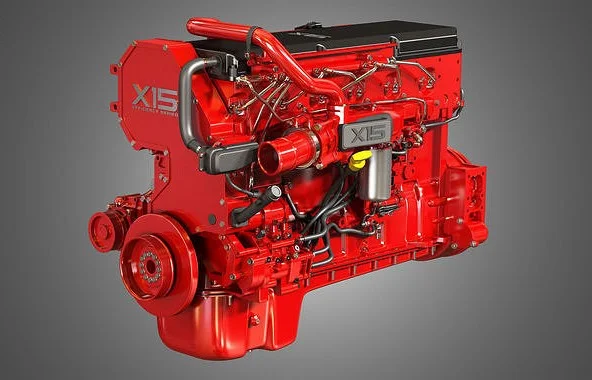The diesel trucking industry is filled with high-end heavy-duty engines—take the Detroit DD15, Paccar MX-13, and Volvo D13 as examples. These are all tough engines capable of hauling tens of thousands of pounds for hundreds of miles without breaking a sweat. However, there’s one heavy-duty engine to rule them all, one that outshines the rest. And that engine is the Cummins X15, a masterclass in performance and efficiency.
The Cummins X15, or the predecessor to the coveted Cummins 15L ISX line, is one of the most widely used diesel engines in the heavy-duty trucking market. With its optimized fuel system, redesigned exhaust, advanced telematics, and combustion process that delivers better fuel efficiency at a fraction of the maintenance cost, the Cummins X15 is the preferred choice for fleet owners across the globe.
But, while the Cummins X15 outclasses its competitors regarding engine power and reliability, it is worth noting that even the most robust engines suffer from their own problems. In this article, we’ll be diving into the most common Cummins X15 problems and the steps you can take to solve them.
COMMON CUMMINS X15 PROBLEMS
Despite its advanced features and capabilities, the Cummins X15 engine isn’t immune to mechanical issues. Below are some of the most common problems experienced by X15 owners and how to fix them.
CLOGGED FUEL FILTERS
If your fleet is sporting a full line-up of Cummins X15 engines, you’ll know that one of the most prevalent problems is the quick clogging of fuel filters, especially in colder climates. This is caused by residual particulate matter in the fuel, though low fuel quality is just as much of a contributing factor. If you’re confident that fuel quality isn’t an issue, replacing your filters with larger gauge filters, adding fuel filter heaters, and installing a tank heater may be the solution.
However, it’s important to note that this can cause other problems and should only be done under expert guidance. Some Cummins X15 owners have reported success in replacing the factory-fitted 10-micron filter with a filter double its size, though this is best left in the hands of a professional.
FUEL PUMP FAILURE
Fuel filters aren’t the only problem with the Cummins X15’s fuel system—ceramic fuel pumps are known to be unstable due to a slipping drive gear, enough to warrant a recall back in 2017. Although this may not seem like a big issue at first, it can cause ongoing problems like sputtering or a stalling engine, lower engine performance due to low oil pressure, extended cranking, and, ultimately, engine failure.
If you suspect a problem with your fuel pump, it’s essential to take your vehicle to a certified Cummins repair shop for inspection and repair. We suggest upgrading the factory-grade Cummins fuel pump with a high-pressure OEM alternative for the most effective results.
CAMSHAFT ISSUES
Just like its predecessor, the Cummins X15 engine is plagued with camshaft issues. However, unlike the ISX15, it isn’t all too bad. In some of the older X15 models, the rocker arms prevent some engine components from getting adequate oil, which causes the rocker arm to stick to and hit the camshaft. Over time, this can flatten the camshaft and result in a loss of engine performance.
While this issue can be challenging to diagnose, a loss of performance is the first sign of camshaft problems. We suggest you take your fleet to a repair shop and get the rocker and camshaft replaced immediately if you’re experiencing these symptoms
LEAKING EGR VALVE
Like most modern heavy-duty engines fitted with an EGR (exhaust gas recirculation) system, issues with a leaking valve can occur over thousands of miles due to wear and tear, clogged passages in the intake manifold, or other after-treatment system issues. While it may not seem significant, the problem can worsen over time and lead to significant performance and emission control issues.
Don’t wait to get your EGR valve repaired—if you notice unusual coolant consumption, fluctuating coolant consumption levels, or white residue indicating burnt coolant, take your truck to a certified heavy-duty repair shop
MID-STOCK CYLINDER LINER
The Cummins X15 comes equipped with a mid-stock steel cylinder liner (also known as a sleeve). If a piston seizes, the cylinder liner can break at the bottom, which can cause the connecting rod or piston to detach and destroy the engine block. To spot any issues in this area quickly, look for signs such as a drop in pressure, leaking coolant, or an overheating engine block. If you notice any of these issues, it’s time to get your cast iron cylinder liner replaced with a high-quality steel alternative.
A quick note: although a steel cylinder liner won’t fix the problem permanently, it’ll give the operator enough time to turn off the engine before it ruptures the engine.
FINAL THOUGHTS
The Cummins X15 engine is a powerful and popular choice for heavy-duty fleet owners and owner-operators alike. But, in spite of its glowing reputation, the X15 is still prone to manufacturer-specific issues. By keeping an eye out for these common Cummins X15 engine issues and addressing them promptly, you can help protect your investment and keep your fleet running at its best for years to come.


